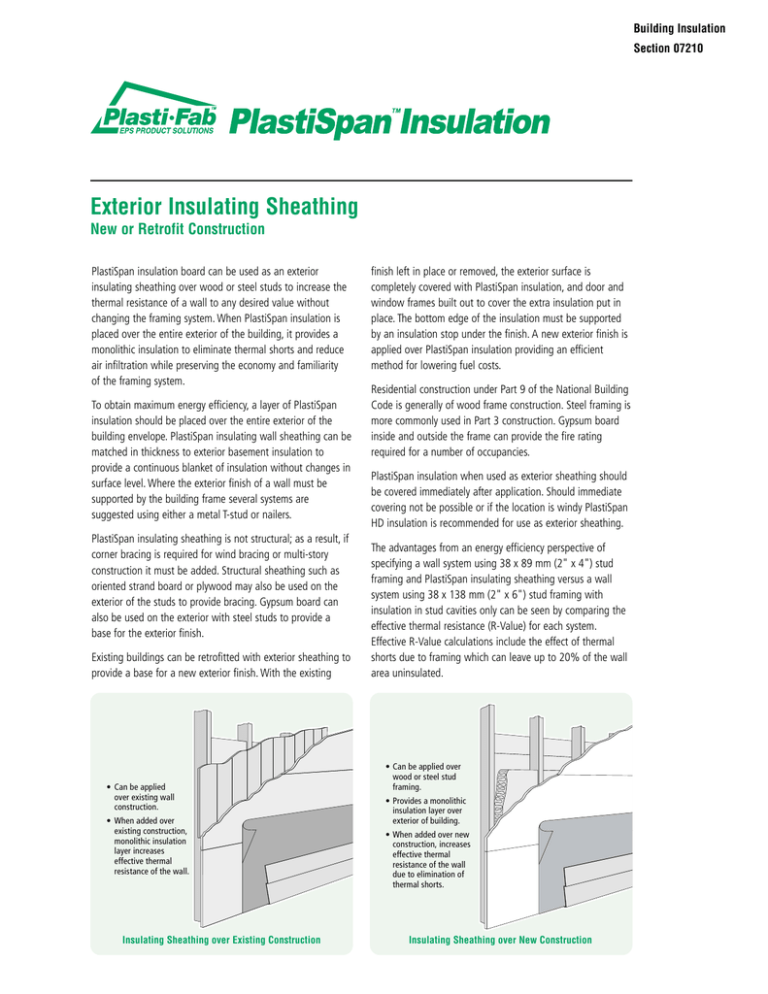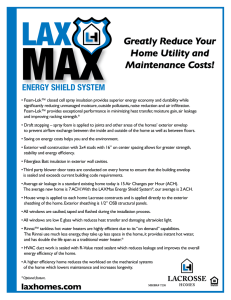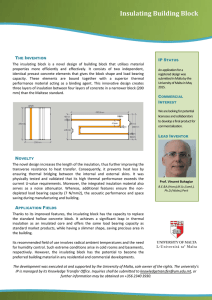
Building Insulation
Section 07210
Exterior Insulating Sheathing
New or Retrofit Construction
PlastiSpan insulation board can be used as an exterior
insulating sheathing over wood or steel studs to increase the
thermal resistance of a wall to any desired value without
changing the framing system. When PlastiSpan insulation is
placed over the entire exterior of the building, it provides a
monolithic insulation to eliminate thermal shorts and reduce
air infiltration while preserving the economy and familiarity
of the framing system.
To obtain maximum energy efficiency, a layer of PlastiSpan
insulation should be placed over the entire exterior of the
building envelope. PlastiSpan insulating wall sheathing can be
matched in thickness to exterior basement insulation to
provide a continuous blanket of insulation without changes in
surface level. Where the exterior finish of a wall must be
supported by the building frame several systems are
suggested using either a metal T-stud or nailers.
PlastiSpan insulating sheathing is not structural; as a result, if
corner bracing is required for wind bracing or multi-story
construction it must be added. Structural sheathing such as
oriented strand board or plywood may also be used on the
exterior of the studs to provide bracing. Gypsum board can
also be used on the exterior with steel studs to provide a
base for the exterior finish.
Existing buildings can be retrofitted with exterior sheathing to
provide a base for a new exterior finish. With the existing
• Can be applied
over existing wall
construction.
• When added over
existing construction,
monolithic insulation
layer increases
effective thermal
resistance of the wall.
Insulating Sheathing over Existing Construction
finish left in place or removed, the exterior surface is
completely covered with PlastiSpan insulation, and door and
window frames built out to cover the extra insulation put in
place. The bottom edge of the insulation must be supported
by an insulation stop under the finish. A new exterior finish is
applied over PlastiSpan insulation providing an efficient
method for lowering fuel costs.
Residential construction under Part 9 of the National Building
Code is generally of wood frame construction. Steel framing is
more commonly used in Part 3 construction. Gypsum board
inside and outside the frame can provide the fire rating
required for a number of occupancies.
PlastiSpan insulation when used as exterior sheathing should
be covered immediately after application. Should immediate
covering not be possible or if the location is windy PlastiSpan
HD insulation is recommended for use as exterior sheathing.
The advantages from an energy efficiency perspective of
specifying a wall system using 38 x 89 mm (2" x 4") stud
framing and PlastiSpan insulating sheathing versus a wall
system using 38 x 138 mm (2" x 6") stud framing with
insulation in stud cavities only can be seen by comparing the
effective thermal resistance (R-Value) for each system.
Effective R-Value calculations include the effect of thermal
shorts due to framing which can leave up to 20% of the wall
area uninsulated.
• Can be applied over
wood or steel stud
framing.
• Provides a monolithic
insulation layer over
exterior of building.
• When added over new
construction, increases
effective thermal
resistance of the wall
due to elimination of
thermal shorts.
Insulating Sheathing over New Construction
Calculation for Wall System Effective Thermal Resistance
Effective =
R-Value
100%
% Area with Framing
R-Value through Framing
% Area without Framing
R-Value through Insulation
+
2 x 4 Stud Wall with R-12 Batt Insulation and
R-8 PlastiSpan Insulating Sheathing
2 x 6 Stud Wall with
R-20 Batt Insulation Only
RSI-VALUE
R-VALUE
RSI-VALUE
THROUGH
FRAMING
THROUGH
INSULATION
THROUGH
FRAMING
THROUGH
INSULATION
Outside Air Film (above grade)
0.03
0.03
0.17
0.17
Metal Siding
0.11
0.11
0.62
0.62
Sheathing Paper
0.01
0.01
0.06
R-8 PlastiSpan Insulation
1.41
1.41
WALL COMPONENT
DESCRIPTION
THROUGH
INSULATION
THROUGH
FRAMING
THROUGH
INSULATION
Outside Air Film (above grade)
0.03
0.03
0.17
0.17
Metal Siding
0.11
0.11
0.62
0.62
0.06
Sheathing Paper
0.01
0.01
0.06
0.06
8.00
8.00
R-20 Batt Insulation
––
3.52
––
20.00
Wood Stud @ 406 mm (16") o.c.
1.13
––
6.44
––
Gypsum Wall Board, 13 mm (1/2")
0.08
0.08
0.45
0.45
Inside Air Film
0.12
0.12
0.68
0.68
Sub-Totals
1.48
3.87
8.42
––
2.11
––
12.00
0.72
––
4.09
––
Gypsum Wall Board, 13 mm (1/2")
0.08
0.08
0.45
0.45
Inside Air Film
0.12
0.12
0.68
0.68
Sub-Totals
2.48
3.87
14.07
EFFECTIVE THERMAL RESISTANCE
RSI 3.50
R-VALUE
THROUGH
FRAMING
Wood Stud @ 406 mm (16") o.c.
R-12 Batt Insulation
PlastiSpan insulating sheathing provides a monolithic insulation
layer over the exterior of the building eliminating thermal shorts
and reducing air infiltration. As well, substitution of 2 x 4 in lieu of
2 x 6 studs retains the familiarity of wood framing, while adding
the economy of 2 x 4 studs.
21.98
R 19.86
Thermal Resistance Calculation – PlastiSpan Insulation over 38 x 89 mm (2” x 4”) Wood Stud Wall
WALL COMPONENT
DESCRIPTION
EFFECTIVE THERMAL RESISTANCE
RSI 2.96
21.98
R 16.83
Thermal Resistance Calculation – 38 x 138 mm (2” x 6”) Wood Stud Wall (Batt Insulation Only)
Selection, Specification and Application Instructions:
1. Scope:
1.1. National Building Code (NBC) Article 9.23.17.4. Insulating Sheathing in Lieu of Sheathing Membrane.
1.2. NBC Sentence 9.23.17.5.(3). - Sheathing Membranes
in Lieu of Sheathing.
2. Materials:
2.1. Insulation Materials:
2.1.1. PlastiSpan insulating sheathing board is an
expanded polystyrene insulation meeting
the requirements of CAN/ULC-S701, Type 1
or Type 2.
2.1.2. PlastiSpan insulation board (Type 1) is listed
in the Canadian Construction Materials Centre
(CCMC) Registry of Product Evaluations under
CCMC evaluation listing 12424-L.
2.1.3. PlastiSpan HD insulation board (Type 2) is
listed in the CCMC Registry of Product
Evaluations under CCMC evaluation
listing 12425-L.
2.1.4. NBC Sentence 9.23.16.3.(1) states that
rigid insulation shall not be used for the
attachment of siding materials. PlastiSpan
insulating sheathing board can provide
backing for exterior cladding.
2.1.5. NBC Article 9.23.17.4. states that where
rigid exterior insulating sheathing, such as
PlastiSpan M24 insulation board with shiplap
edges, is installed, a separate sheathing
membrane is not required since the joints are
lapped and detailed to ensure drainage of
water to the exterior.
2.1.6. The shiplap edges of PlastiSpan M24 insulation
butted tightly together will provide a tight
joint, so taping or caulking of joints will not
be required.
2.1.7. Sentence 9.23.17.5.(3) states that PlastiSpan
insulating sheathing board with joints not
detailed as per 2.1.5 above can be used in lieu
of one of the two layers of sheathing paper
required per NBC Sentence 9.23.17.5.(1).
2.2. Other Materials:
2.2.1. Caulking adhesives used shall conform to
CGSB Standard 71-GP-24M, Adhesive, Flexible,
for Bonding Cellular Polystyrene Insulation.
2.2.2. Construction tape used shall be any
commercially available construction tape such
as 3M, Venture or equivalent.
2.2.3. Foam-in-place polyurethane shall be
commercially available material compatible
with polystyrene insulation.
2.2.4. Fasteners must have heads or washers at least
12.7 mm (1/2”) in diameter,where the cladding
is applied directly against the insulation, and
at least 25.4 mm (1”) diameter, where an
air space between the insulation and the
cladding exists.
Selection, Specification and Application Instructions:
3. Installation:
3.1. General:
3.1.1. Install PlastiSpan insulating sheathing board
on the exterior of wood stud construction
with all joints butted tightly together and
vertical joints made at wood stud locations.
3.1.1.1. If 600 mm x 2440 mm (2 x 8 ft)
boards, install board horizontally.
3.1.1.2. If 1220 mm x 2440 mm (4 x 8 ft)
boards, install boards vertically.
3.1.2. Since PlastiSpan insulating sheathing board is
not a structural sheathing, temporary wind
bracing will be required until interior gypsum
board is installed. NBC Sentence 9.23.10.2.(3)
provides acceptable corner bracing methods.
Typical methods used include:
3.1.2.1. diagonal 19 mm x 89 mm (1” x 4”)
let-in wood bracing,
3.1.2.2. flat or profiled steel strap bracing, or
3.1.2.3. OSB or plywood sheets at corners
overlaid with PlastiSpan insulating
sheathing.
3.1.3. Installation of batt insulation between wood
studs and interior vapour barrier shall be
completed following normal construction
practices and in conformance with the
applicable section of the Code.
3.1.4. When used as a backing for exterior cladding,
PlastiSpan insulating sheathing board shall be
fastened to framing as per section 2.1.4
above using fasteners as described in section
2.2.4. above as follows:
3.1.4.1. at a spacing of not more than
150 mm (6”) centres along its
vertical edges and
3.1.4.2. on a grid of not more than 300 mm.
x 600 mm. (12” x 24”) for the
remainder of the sheet
3.1.5. Cladding materials shall be nailed through
PlastiSpan insulating sheathing board into the
framing members, furring members or to
blocking between the framing members as
stated in NBC Sentence 9.27.5.1.(1) using
fasteners that are minimum of 25 mm (1”)
longer than the sheathing thickness used.
3.1.6. Fasteners for shakes and shingles shall
penetrate into the framing not less than 19 mm
(3/4”). Fasteners for other types of cladding
shall penetrate into the framing not less than
25 mm (1”).
3.1.7. Use a suitable material as per section 2.2.2 or
2.2.3 above to seal joints that have been cut or
damaged. Typical locations where the joint may
be cut include at corners or around windows
and doors.
3.1.8. When PlastiSpan insulating sheathing as per
sections 2.1.5 and 2.1.6 is installed, a separate
sheathing membrane is not required to be used
over PlastiSpan insulating sheathing board.
3.1.9. When PlastiSpan insulating sheathing as per
section 2.1.7 is installed, install at least one
layer of sheathing paper in conjunction with
PlastiSpan insulating sheathing board.
Wall Insulation:
Exterior Insulation Sheathing
PlastiSpan Insulation Properties
CAN/ULC-S701
MATERIAL PROPERTIES
TEST METHOD
METRIC (SI) UNITS
Min. @ mean temp. 24 °C (75° F)
ASTM C 518
°C
W • 25 mm
0.65
0.70
kPa
70
kPa
Thermal Resistance
Compressive Resistance
ASTM D 1621
Minimum @ 10% Deformation
Procedure A
Flexural Strength
ASTM C 203
Minimum
Procedure B
Water Vapour Permanence 1
Maximum
ASTM E 96
CAN/ULC-S701
IMPERIAL UNITS
TYPE 1
TYPE 2
hr • °F
BTU • in
3.75
4.04
110
psi
10
16
170
240
psi
25
35
ng
Pa • s • m2
300
200
perms
5.2
3.5
m2 •
TYPE 1
TYPE 2
ft2 •
Dimensional Stability
ASTM D 2126
Maximum
7 days @ 70 ± 2° C
% linear change
1.5
1.5
% linear change
1.5
1.5
ASTM D 2842
% by volume
6.0
4.0
% by volume
6.0
4.0
ASTM D 2863
%
24
24
%
24
24
Water Absorption
Maximum
Limiting Oxygen Index 2
Minimum
NOTES: 1. PlastiSpan insulation is manufactured under a third party certification program monitored by Underwriters’ Laboratories of Canada and is listed in the Canadian Construction
Materials Centre (CCMC) Registry of Product Evaluations.
2. PlastiSpan insulation board has a maximum Flame Spread Rating of 290 and a Smoke Developed Rating greater than 500 for minimum thickness of 25 mm classified in
accordance with CAN/ULC–S102.2M.
Made with
ECP-Certified
Copyright © 2004 by Plasti-Fab Ltd. All rights reserved.
Plasti-Fab and PlastiSpan are registered trademarks of
Plasti-Fab Ltd. Printed in Canada.



